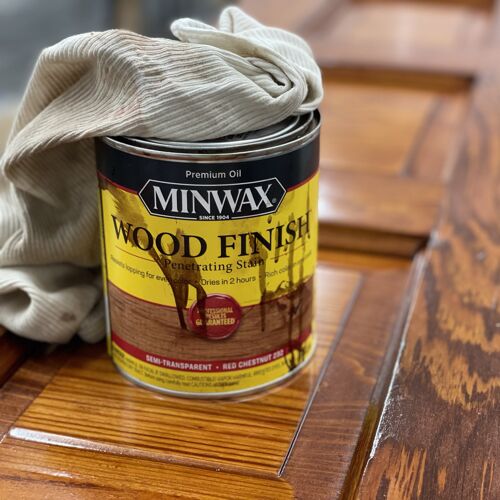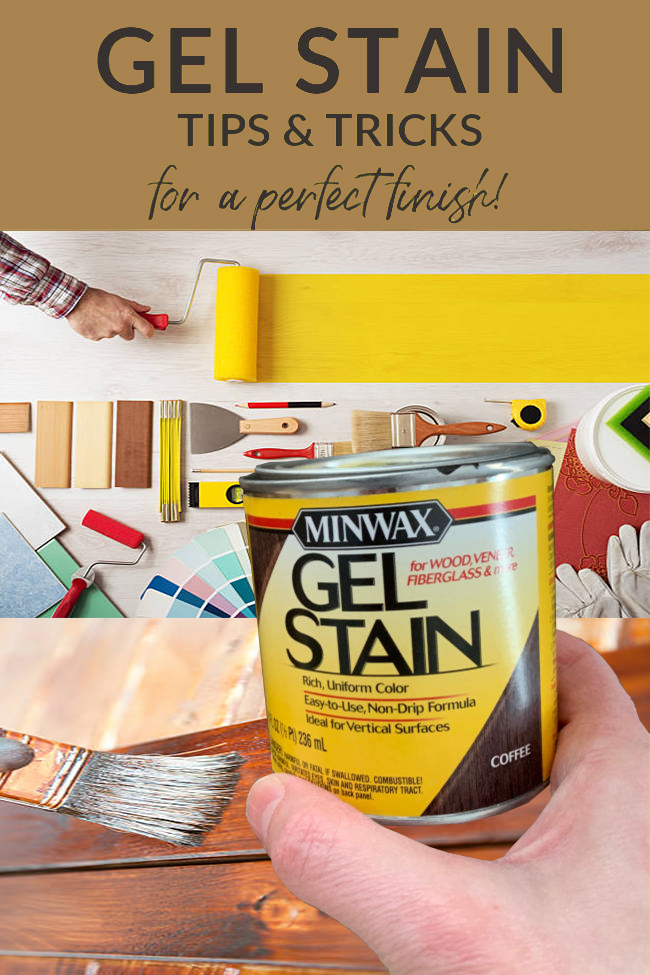The best way to apply stain to furniture is with a clean cloth, using even strokes. Ensure the wood is prepped and sanded for optimal absorption.
Staining furniture enhances its beauty and provides long-lasting protection. Choosing the right stain and applying it correctly are crucial for achieving a professional finish. Before you begin, select a stain type that complements the wood and desired aesthetic. Preparing the surface by cleaning and sanding it down is essential for an even application.
It’s advisable to perform a patch test in an inconspicuous area to gauge the color and compatibility. Adequate ventilation and protective gear are also important for safety. Following the grain of the wood and applying the stain in manageable sections will help avoid streaks and blotches. Remember to wipe off excess stain to prevent a sticky residue. With patience and attention to detail, you can give your furniture a new lease of life.

Preparing Your Workspace
Before diving into the process of staining your furniture, it’s vital to prepare your workspace properly. A well-set environment not only ensures safety but also enhances the quality of your work. Let’s walk through the essential steps to get your space stain-ready.
Choosing The Right Environment
You need a clean, dry, and dust-free area to work in. The space should also be roomy enough to move around your furniture piece with ease. Avoid direct sunlight and areas with high humidity to prevent uneven drying.
Setting Up Ventilation
Proper airflow is crucial when applying stain due to the fumes. Open windows or use fans. Ensure continuous air movement throughout the process. If possible, work outdoors for optimal ventilation.
Protecting Surfaces
Prevent staining spills from damaging your floors or workbench. Lay down plastic sheeting or old newspapers. Secure them with painter’s tape. Place the furniture atop the covering before starting your project.
- Clear the area of unnecessary items.
- Arrange your tools within easy reach.
- Have cleaning materials handy for spills.
Selecting Your Stain
Embarking on a furniture staining project starts with one crucial step: Selecting Your Stain. This decision shapes the final appearance and durability of your piece. Think of stain as not just color, but as a protector and enhancer of the natural beauty of the wood.
Oil Vs. Water-based Stains
Choosing between oil and water-based stains is a foundational decision. Oil-based stains penetrate deeply, providing rich color and longer drying times. This allows for more working time. They enhance the wood’s natural pattern, making grain lines pop with vivid detail. On the other hand, water-based stains offer faster drying times and easy cleanup with soap and water. Environmental impact is lower due to reduced volatile organic compounds (VOCs).
Consider the following to decide:
- Work environment: Do you have ample ventilation?
- Time frame: Is the quick drying of water-based preferable?
- Cleanup: Do you prioritize easy water cleanup?
Matching Stain To Wood Type
The wood type dictates stain compatibility. Softwoods, like pine, absorb stain unevenly, often requiring a conditioner for an even finish. Hardwoods, such as oak, showcase the stain’s full depth and even application. Consider these key points:
| Wood Type | Stain Compatibility |
|---|---|
| Pine | May need conditioner |
| Oak | Displays full depth |
| Maple | Can appear blotchy |
Testing Stain On Scrap Wood
Always test the stain on a piece of scrap wood. Scrap wood testing reveals the true color and helps avoid unwanted surprises. Follow these steps:
- Sand the scrap piece as you would your project.
- Apply the stain you are considering using.
- Wait for the stain to fully dry.
- Observe the color in different lights.
This test makes it clear how your furniture will look once stained.
Prepping The Furniture
Introduction to Prepping the Furniture
Successful staining starts with proper prep work. Before a brush ever touches the wood, the furniture must be ready to accept the stain. Proper preparation ensures a smooth, even finish that lasts. Read on to master the essential steps of prepping your furniture for a stain application that looks flawless.
Cleaning the Surface
Cleaning The Surface
Begin with a clean canvas. Remove dirt, dust, and grime to avoid a splotchy appearance. Use a gentle cleaner and a soft cloth:
- Wipe down the surface.
- Rinse with clean water if necessary.
- Let the wood dry completely before the next step.
Sanding Techniques
Sanding Techniques
Sanding smooths the wood and helps the stain stick better. Follow these steps:
- Start with a medium-grit sandpaper.
- Progress to a fine-grit paper for a velvety finish.
- Always sand in the direction of the grain.
- Clean the surface again to remove any sawdust.
Repairing Imperfections
Repairing Imperfections
Fills cracks and holes for an even surface. Use wood filler that matches the wood’s color:
| Step | Action |
|---|---|
| 1 | Apply the filler with a putty knife. |
| 2 | Smooth it out. |
| 3 | Wait for it to dry. |
| 4 | Sand the area again. |

Application Methods
Staining furniture can transform its look. The key is in the application. Let’s dive into methods that bring out the beauty in wood.
Brush Vs. Rag Application
Choosing the right tool is crucial. A brush works great for detailed areas. It gets into nooks and crannies. A rag applies stain over large, flat surfaces more easily. It also wipes away excess for a smooth finish. Brush application is precise. Rag application is effective for a uniform coat.
- Brush: Good for hard-to-reach spots
- Rag: Best for large, even surfaces
Applying Even Coats
Consistency is key. Start with light layers. Adding more stain is easier than removing it. Test the stain on a hidden part first. This ensures color matches expectations. Use long, even strokes. This avoids uneven shades
- Test stain on a hidden area
- Apply in long, even strokes
- Allow proper drying time between coats
Avoiding Drips And Runs
Prevent a messy finish. Drips and runs ruin a smooth look. Work in a well-lit area. This helps spot drips early. Apply stain with the grain. Keep a clean rag handy. Wipe drips immediately. Thin coats are less likely to drip.
| Tip | Benefit |
|---|---|
| Work in good lighting | Easier to spot and fix drips |
| Wipe excess stain quickly | Prevents staining other areas |
| Apply thin coats | Reduces chances of drips and runs |
Drying And Curing
Applying stain to furniture transforms its appearance, lifting its aesthetic to new heights. Yet, the magic lies not just in the application but also in the drying and curing process. Proper handling of drying and curing stages ensures a sleek, long-lasting finish. Let’s dive into the nuances of these pivotal steps.
Understanding Drying Times
Grasping drying times is crucial for a stellar finish. Drying time may vary based on stain type and environmental factors.
- Oil-based stains: typically take 6-8 hours to dry.
- Water-based stains: often dry within 2-4 hours.
Read labels carefully; they provide specific drying time instructions.
Conditions That Affect Drying
Diverse conditions can alter stain drying times. Awareness and adjustment to these can aid in optimal results.
| Condition | Impact |
|---|---|
| Humidity | Higher humidity can prolong drying times. |
| Temperature | Colder temperatures may slow down the drying process. |
| Ventilation | Better air circulation facilitates faster drying. |
When To Apply A Second Coat
Patience is key before adding a second stain coat. Rules of thumb include:
- Ensure the first coat is tact-free.
- Refer to the product’s specific recoating window.
- Wait the minimum recommended time, typically overnight.
Following these steps will guarantee a durable, even finish.
Adding The Finishing Touches
Now that your furniture piece boasts a fresh coat of stain, it’s time for Adding the Finishing Touches. These essential steps will ensure durability, improve appearance, and extend the life of your furniture.
Sealing The Stain
Sealing is crucial to protect the wood and keep the stain looking great.
- Choose the right sealant: Polyurethane, lacquer, or shellac work well.
- Apply evenly: Use a clean brush or rag to avoid streaks.
- Allow it to dry: Wait for the recommended time before use.
Buffing For Smoothness
A perfectly smooth finish is pleasing to the touch and the eye.
- Use fine-grit sandpaper: Lightly sand the surface for evenness.
- Wipe off the dust: Clean with a tack cloth or microfiber rag.
- Buff again if necessary: Ensure a silky-smooth surface.
Maintaining The Finish
Good maintenance extends the life of the stained furniture.
- Regular dusting: Prevents scratches and dullness.
- Cleanup spills quickly: Avoids water rings and stains.
- Avoid direct sunlight: Preserves the color and prevents fading.

Frequently Asked Questions On Best Way To Put Stain On Furniture
What Is The Best Stain For Furniture?
The best furniture stain depends on the wood type and desired finish. Oil-based stains penetrate deeply, offering rich, long-lasting colors. Water-based stains are eco-friendlier and dry faster but may require more coats for a vibrant finish.
How To Prepare Furniture For Staining?
Preparing furniture for staining involves cleaning, sanding, and wiping down with a tack cloth. Start with coarse sandpaper and progress to a finer grit for a smooth surface. Always sand in the direction of the wood grain for best results.
Can You Stain Over Already Stained Wood?
Yes, staining over already stained wood is possible. However, the existing finish must be compatible with the new stain, and the surface needs proper preparation. Light sanding can help the new stain adhere and blend evenly.
How Many Coats Of Stain On Furniture?
Usually, 1-2 coats of stain are sufficient for furniture. The first coat penetrates and colors the wood, while the second coat deepens the hue. Always wait for the first coat to dry fully before applying the second.
Conclusion
Applying stain to furniture revitalizes its appearance and protects the wood. Remember, even application is key, and choosing the right stain makes a difference. Tackle your next DIY project with confidence, using these best practices to ensure timeless, beautiful results.
Your furnishings will thank you with a prolonged, lustrous life. Happy staining!

I am a home Specialized writer and blogger based in the USA, Canada, Australia & UK. I have four years of experience in home and all types of Category. So I work on solving these issues and give various Resource on these issues.

